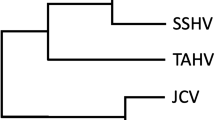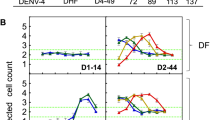Abstract
While studying virus neutralization of many togaviruses by antisera raised in chickens, Hawkes and Lafferty1,2 observed a significant increase of plaque counts above controls when virus–antibody mixtures were assayed on chick embryo (CE) cell monolayers, or monolayers derived from other avian embryos. Among those antisera tested, partial neutralizing activity was observed at low dilutions and plaque enhancement at high dilutions above the neutralizing end point. These studies interested us because of the many apparent similarities between plaque enhancement and enhanced replication of dengue virus in mononuclear phagocytes. The latter has been shown to be mediated by anti-dengue IgG at dilutions above neutralization end points. When non-neutralized immune complexes are formed between dengue virus and antibody molecules, the Fc termini attach to cell receptors and complexes are internalized; this facilitates infection and results in enhanced production of virus3,4. The same phenomenon has been extended to West Nile (WN) virus demonstrated on mouse macrophage cell lines by Peiris and Porterfield5. Here, we have examined the infection of CE cells with virus–antibody complexes of another flavivirus, Murray Valley encephalitis (MVE) virus. Our results show that a similar mechanism operates in the antibody-mediated viral plaque enhancement of MVE virus on CE cells.
This is a preview of subscription content, access via your institution
Access options
Subscribe to this journal
Receive 51 print issues and online access
$199.00 per year
only $3.90 per issue
Buy this article
- Purchase on Springer Link
- Instant access to full article PDF
Prices may be subject to local taxes which are calculated during checkout
Similar content being viewed by others
References
Hawkes, R. A. Aust. J. exp. Biol. med. Sci. 42, 465–482 (1964).
Hawkes, R. A. & Lafferty, K. J. Virology 33, 250–261 (1967).
Halstead, S. B. & O'Rourke, E. J. J. exp. Med. 146, 201–217 (1977).
Halstead, S. B., O'Rourke, E. J. & Allison, A. C. J. exp. Med. 146, 218–229 (1977).
Peiris, J. S. M. & Porterfield, J. S. Nature 282, 509–511 (1979).
Porter, R. R. Biochem. J. 73, 119–126 (1959).
Ewald, S., Freedman, L. & Sanders, B. G. Cell. Immun. 31, 847–854 (1976).
Ewald, S., Freedman, L. & Sanders, B. G. Cell. Immun. 23, 158–170 (1976).
Dickler, H. B. J. exp. Med. 140, 508–521 (1974).
Lee, L. F. Avian Dis. 18, 602–609 (1974).
Author information
Authors and Affiliations
Rights and permissions
About this article
Cite this article
Kliks, S., Halstead, S. An explanation for enhanced virus plaque formation in chick embryo cells. Nature 285, 504–505 (1980). https://doi.org/10.1038/285504a0
Received:
Accepted:
Issue Date:
DOI: https://doi.org/10.1038/285504a0
This article is cited by
-
Vaccine-Associated Enhanced Viral Disease: Implications for Viral Vaccine Development
BioDrugs (2021)
-
Macrophages and control of granulomatous inflammation in tuberculosis
Mucosal Immunology (2011)
-
A study on the mechanism of antibody-dependent enhancement of feline infectious peritonitis virus infection in feline macrophages by monoclonal antibodies
Archives of Virology (1991)
Comments
By submitting a comment you agree to abide by our Terms and Community Guidelines. If you find something abusive or that does not comply with our terms or guidelines please flag it as inappropriate.



